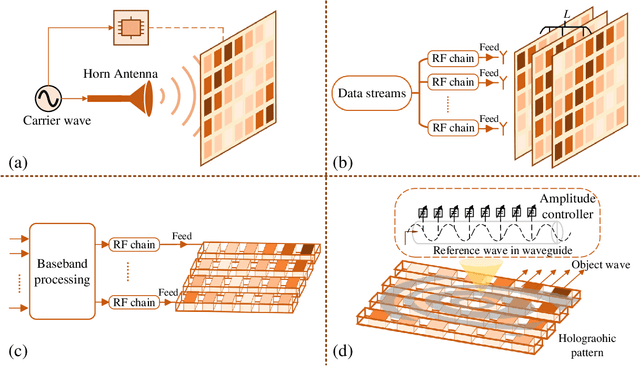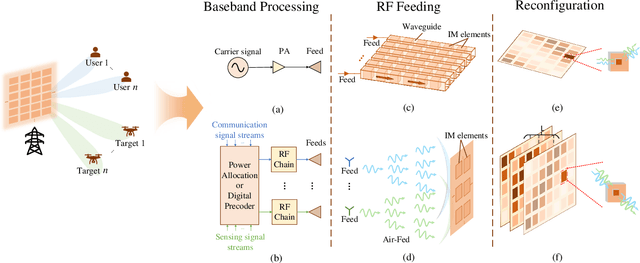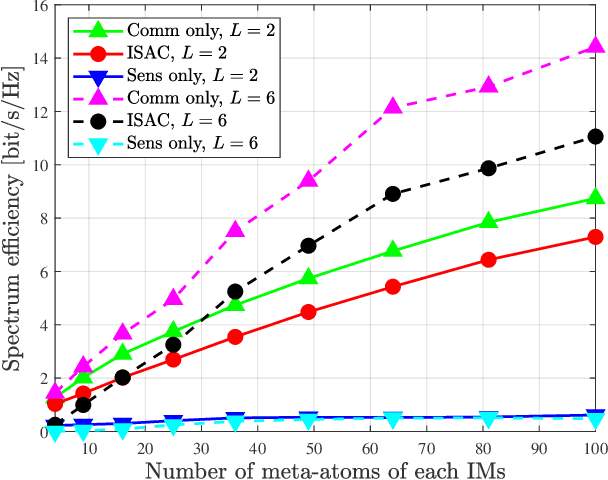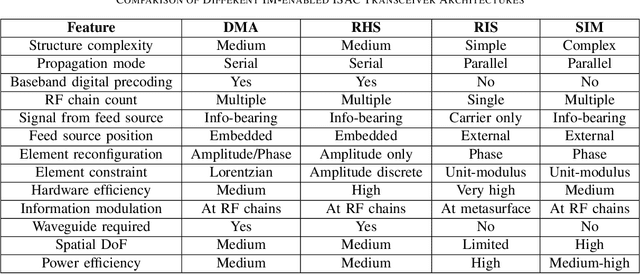Zhen Gao
Performance Optimization for Movable Antenna Enhanced MISO-OFDM Systems
Oct 02, 2025Abstract:Movable antenna (MA) technology offers a flexible approach to enhancing wireless channel conditions by adjusting antenna positions within a designated region. While most existing works focus on narrowband MA systems, this paper investigates MA position optimization for an MA-enhanced multiple-input single-output (MISO) orthogonal frequency-division multiplexing (OFDM) system. This problem appears to be particularly challenging due to the frequency-flat nature of MA positioning, which should accommodate the channel conditions across different subcarriers. To overcome this challenge, we discretize the movement region into a multitude of sampling points, thereby converting the continuous position optimization problem into a discrete point selection problem. Although this problem is combinatorial, we develop an efficient partial enumeration algorithm to find the optimal solution using a branch-and-bound framework, where a graph-theoretic method is incorporated to effectively prune suboptimal solutions. In the low signal-to-noise ratio (SNR) regime, a simplified graph-based algorithm is also proposed to obtain the optimal MA positions without the need for enumeration. Simulation results reveal that the proposed algorithm outperforms conventional fixed-position antennas (FPAs), while narrowband-based antenna position optimization can achieve near-optimal performance.
Radiation Pattern Reconfigurable FAS-Empowered Interference-Resilient UAV Communication
Oct 01, 2025Abstract:The widespread use of uncrewed aerial vehicles (UAVs) has propelled the development of advanced techniques on countering unauthorized UAV flights. However, the resistance of legal UAVs to illegal interference remains under-addressed. This paper proposes radiation pattern reconfigurable fluid antenna systems (RPR-FAS)-empowered interference-resilient UAV communication scheme. This scheme integrates the reconfigurable pixel antenna technology, which provides each antenna with an adjustable radiation pattern. Therefore, RPR-FAS can enhance the angular resolution of a UAV with a limited number of antennas, thereby improving spectral efficiency (SE) and interference resilience. Specifically, we first design dedicated radiation pattern adapted from 3GPP-TR-38.901, where the beam direction and half power beamwidth are tailored for UAV communications. Furthermore, we propose a low-storage-overhead orthogonal matching pursuit multiple measurement vectors algorithm, which accurately estimates the angle-of-arrival (AoA) of the communication link, even in the single antenna case. Particularly, by utilizing the Fourier transform to the radiation pattern gain matrix, we design a dimension-reduction technique to achieve 1--2 order-of-magnitude reduction in storage requirements. Meanwhile, we propose a maximum likelihood interference AoA estimation method based on the law of large numbers, so that the SE can be further improved. Finally, alternating optimization is employed to obtain the optimal uplink radiation pattern and combiner, while an exhaustive search is applied to determine the optimal downlink pattern, complemented by the water-filling algorithm for beamforming. Comprehensive simulations demonstrate that the proposed schemes outperform traditional methods in terms of angular sensing precision and spectral efficiency.
Intelligent Metasurface-Enabled Integrated Sensing and Communication: Unified Framework and Key Technologies
Jun 16, 2025



Abstract:As the demand for ubiquitous connectivity and high-precision environmental awareness grows, integrated sensing and communication (ISAC) has emerged as a key technology for sixth-generation (6G) wireless networks. Intelligent metasurfaces (IMs) have also been widely adopted in ISAC scenarios due to their efficient, programmable control over electromagnetic waves. This provides a versatile solution that meets the dual-function requirements of next-generation networks. Although reconfigurable intelligent surfaces (RISs) have been extensively studied for manipulating the propagation channel between base and mobile stations, the full potential of IMs in ISAC transceiver design remains under-explored. Against this backdrop, this article explores emerging IM-enabled transceiver designs for ISAC systems. It begins with an overview of representative IM architectures, their unique principles, and their inherent advantages in EM wave manipulation. Next, a unified ISAC framework is established to systematically model the design and derivation of diverse IM-enabled transceiver structures. This lays the foundation for performance optimization, trade-offs, and analysis. The paper then discusses several critical technologies for IM-enabled ISAC transceivers, including dedicated channel modeling, effective channel estimation, tailored beamforming strategies, and dual-functional waveform design.
Residual Cross-Attention Transformer-Based Multi-User CSI Feedback with Deep Joint Source-Channel Coding
May 26, 2025Abstract:This letter proposes a deep-learning (DL)-based multi-user channel state information (CSI) feedback framework for massive multiple-input multiple-output systems, where the deep joint source-channel coding (DJSCC) is utilized to improve the CSI reconstruction accuracy. Specifically, we design a multi-user joint CSI feedback framework, whereby the CSI correlation of nearby users is utilized to reduce the feedback overhead. Under the framework, we propose a new residual cross-attention transformer architecture, which is deployed at the base station to further improve the CSI feedback performance. Moreover, to tackle the "cliff-effect" of conventional bit-level CSI feedback approaches, we integrated DJSCC into the multi-user CSI feedback, together with utilizing a two-stage training scheme to adapt to varying uplink noise levels. Experimental results demonstrate the superiority of our methods in CSI feedback performance, with low network complexity and better scalability.
Chirp Delay-Doppler Domain Modulation: A New Paradigm of Integrated Sensing and Communication for Autonomous Vehicles
May 22, 2025Abstract:Autonomous driving is reshaping the way humans travel, with millimeter wave (mmWave) radar playing a crucial role in this transformation to enabe vehicle-to-everything (V2X). Although chirp is widely used in mmWave radar systems for its strong sensing capabilities, the lack of integrated communication functions in existing systems may limit further advancement of autonomous driving. In light of this, we first design ``dedicated chirps" tailored for sensing chirp signals in the environment, facilitating the identification of idle time-frequency resources. Based on these dedicated chirps, we propose a chirp-division multiple access (Chirp-DMA) scheme, enabling multiple pairs of mmWave radar transceivers to perform integrated sensing and communication (ISAC) without interference. Subsequently, we propose two chirp-based delay-Doppler domain modulation schemes that enable each pair of mmWave radar transceivers to simultaneously sense and communicate within their respective time-frequency resource blocks. The modulation schemes are based on different multiple-input multiple-output (MIMO) radar schemes: the time division multiplexing (TDM)-based scheme offers higher communication rates, while the Doppler division multiplexing (DDM)-based scheme is suitable for working in a lower signal-to-noise ratio range. We then validate the effectiveness of the proposed DDM-based scheme through simulations. Finally, we present some challenges and issues that need to be addressed to advance ISAC in V2X for better autonomous driving. Simulation codes are provided to reproduce the results in this paper: \href{https://github.com/LiZhuoRan0/2025-IEEE-Network-ChirpDelayDopplerModulationISAC}{https://github.com/LiZhuoRan0}.
Toward Near-Space Communication Network in the 6G and Beyond Era
May 18, 2025Abstract:Near-space communication network (NS-ComNet), as an indispensable component of sixth-generation (6G) and beyond mobile communication systems and the space-air-ground-sea integrated network (SAGSIN), demonstrates unique advantages in wide-area coverage, long-endurance high-altitude operation, and highly flexible deployment. This paper presents a comprehensive review of NS-ComNet for 6G and beyond era. Specifically, by contrasting satellite, low-altitude unmanned-aerial-vehicle (UAV), and terrestrial communications, we first elucidate the background and motivation for integrating NS-ComNet into 6G network architectures. Subsequently, we review the developmental status of near-space platforms, including high-altitude balloons, solar-powered UAVs, and stratospheric airships, and analyze critical challenges faced by NS-ComNet. To address these challenges, the research focuses on key enabling technologies such as topology design, resource and handover management, multi-objective joint optimization, etc., with particular emphasis on artificial intelligence techniques for NS-ComNet. Finally, envisioning future intelligent collaborative networks that integrate NS-ComNet with satellite-UAV-terrestrial systems, we explore promising directions. This paper aims to provide technical insights and research foundations for the systematic construction of NS-ComNet and its deep deployment in the 6G and beyond era.
Generative Diffusion Model Driven Massive Random Access in Massive MIMO Systems
May 18, 2025Abstract:Massive random access is an important technology for achieving ultra-massive connectivity in next-generation wireless communication systems. It aims to address key challenges during the initial access phase, including active user detection (AUD), channel estimation (CE), and data detection (DD). This paper examines massive access in massive multiple-input multiple-output (MIMO) systems, where deep learning is used to tackle the challenging AUD, CE, and DD functions. First, we introduce a Transformer-AUD scheme tailored for variable pilot-length access. This approach integrates pilot length information and a spatial correlation module into a Transformer-based detector, enabling a single model to generalize across various pilot lengths and antenna numbers. Next, we propose a generative diffusion model (GDM)-driven iterative CE and DD framework. The GDM employs a score function to capture the posterior distributions of massive MIMO channels and data symbols. Part of the score function is learned from the channel dataset via neural networks, while the remaining score component is derived in a closed form by applying the symbol prior constellation distribution and known transmission model. Utilizing these posterior scores, we design an asynchronous alternating CE and DD framework that employs a predictor-corrector sampling technique to iteratively generate channel estimation and data detection results during the reverse diffusion process. Simulation results demonstrate that our proposed approaches significantly outperform baseline methods with respect to AUD, CE, and DD.
ToDMA: Large Model-Driven Token-Domain Multiple Access for Semantic Communications
May 16, 2025Abstract:Token communications (TokCom) is an emerging generative semantic communication concept that reduces transmission rates by using context and multimodal large language model (MLLM)-based token processing, with tokens serving as universal semantic units across modalities. In this paper, we propose a semantic multiple access scheme in the token domain, referred to as token domain multiple access (ToDMA), where a large number of devices share a token codebook and a modulation codebook for source and channel coding, respectively. Specifically, each transmitter first tokenizes its source signal and modulate each token to a codeword. At the receiver, compressed sensing is employed first to detect active tokens and the corresponding channel state information (CSI) from the superposed signals. Then, the source token sequences are reconstructed by clustering the token-associated CSI across multiple time slots. In case of token collisions, some active tokens cannot be assigned and some positions in the reconstructed token sequences are empty. We propose to use pre-trained MLLMs to leverage the context, predict masked tokens, and thus mitigate token collisions. Simulation results demonstrate the effectiveness of the proposed ToDMA framework for both text and image transmission tasks, achieving significantly lower latency compared to context-unaware orthogonal communication schemes, while also delivering superior distortion and perceptual quality compared to state-of-the-art context-unaware non-orthogonal communication methods.
MmWave-LoRadar Empowered Vehicular Integrated Sensing and Communication Systems: LoRa Meets FMCW
May 16, 2025Abstract:The integrated sensing and communication (ISAC) technique is regarded as a key component in future vehicular applications. In this paper, we propose an ISAC solution that integrates Long Range (LoRa) modulation with frequency-modulated continuous wave (FMCW) radar in the millimeter-wave (mmWave) band, called mmWave-LoRadar. This design introduces the sensing capabilities to the LoRa communication with a simplified hardware architecture. Particularly, we uncover the dual discontinuity issues in time and phase of the mmWave-LoRadar received signals, rendering conventional signal processing techniques ineffective. As a remedy, we propose a corresponding hardware design and signal processing schemes under the compressed sampling framework. These techniques effectively cope with the dual discontinuity issues and mitigate the demands for high-sampling-rate analog-to-digital converters while achieving good performance. Simulation results demonstrate the superiority of the mmWave-LoRadar ISAC system in vehicular communication and sensing networks.
Channel Fingerprint Construction for Massive MIMO: A Deep Conditional Generative Approach
May 12, 2025Abstract:Accurate channel state information (CSI) acquisition for massive multiple-input multiple-output (MIMO) systems is essential for future mobile communication networks. Channel fingerprint (CF), also referred to as channel knowledge map, is a key enabler for intelligent environment-aware communication and can facilitate CSI acquisition. However, due to the cost limitations of practical sensing nodes and test vehicles, the resulting CF is typically coarse-grained, making it insufficient for wireless transceiver design. In this work, we introduce the concept of CF twins and design a conditional generative diffusion model (CGDM) with strong implicit prior learning capabilities as the computational core of the CF twin to establish the connection between coarse- and fine-grained CFs. Specifically, we employ a variational inference technique to derive the evidence lower bound (ELBO) for the log-marginal distribution of the observed fine-grained CF conditioned on the coarse-grained CF, enabling the CGDM to learn the complicated distribution of the target data. During the denoising neural network optimization, the coarse-grained CF is introduced as side information to accurately guide the conditioned generation of the CGDM. To make the proposed CGDM lightweight, we further leverage the additivity of network layers and introduce a one-shot pruning approach along with a multi-objective knowledge distillation technique. Experimental results show that the proposed approach exhibits significant improvement in reconstruction performance compared to the baselines. Additionally, zero-shot testing on reconstruction tasks with different magnification factors further demonstrates the scalability and generalization ability of the proposed approach.
 Add to Chrome
Add to Chrome Add to Firefox
Add to Firefox Add to Edge
Add to Edge